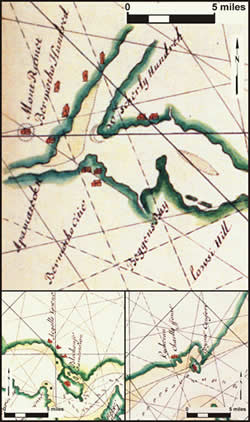High-Priority Sites
There is so much of significance about Hopewell's past that it is difficult and probably a mistake to put emphasis on one period over another. At the same time, the realities of the long-term planning process require setting priorities. Based on the goals set forth in the preceding paragraph, we recommend certain areas and sites over others for initial investigation. For reference, an overview of local history and a summary of recent archaeological work at City Point are to be found in our technical report for work completed in 2002. Also, citizen comments made at a recent town hall meeting on historic preservation are reflected in the following recommendations.
 Early Colonial "Bermuda City" (ca. 1614 – 1622)
Early Colonial "Bermuda City" (ca. 1614 – 1622)
One of the earliest English settlements established after the founding of Jamestown was sited in the area of Hopewell. Discovery of one or more of these sites would mark an important contribution to the 2007 observance. While the precise location is not known, due in large measure to the sketchy accounts in original records, there are clues that indicate an archaeological search would be most profitable in the general City Point area. A recently discovered mariner's chart drawn in the first half of the seventeenth century seems to confirm this interpretation of the early written records (Vingboons 1639). Although Bermuda City was quite small and short-lived, we now are fairly certain that it was located somewhere between Gravelly Run and the Route 10 bridge crossing of the Appomattox River. Several of the written accounts refer to the naturally defensible situation of Bermuda City, indicating high ground with commanding views of the major rivers. Based on this evidence, we recommend archaeological survey focused on the margins of major and minor streams at City Point, including the James River, Gravelly Run, and other tributaries.
Jamestown-era Indian Sites
The English colonists described encounters with Indians known as the Appomattuck around present-day Hopewell. Their communities were situated over the area surrounding the confluence of the Appomattox and James rivers. Few of them have been identified and fewer still have been the object of sustained study. Knowledge of how the Indians and English interacted is critical to interpretation of the Jamestown period. These sites will most likely occur in precisely the same locations chosen later by Euro-Americans for their principal settlements.
Other Seventeenth-Century Colonial Sites
Early land grant records provide evidence about the phase of English settlement that followed the demise of Bermuda City in 1622. The best known of these early claims to land in the Hopewell area is Francis Eppes' 1700-acre patent for City Point. Other early patents mention land near the mouth of Baileys Creek and Cabin Creek. A very important area is the location of a successor to the Bermuda City community that seems to have been established by the mid-seventeenth century near Broadway Landing. Nearby along Cabin Creek, an early colonial church that served this community survived until the Civil War. Reports have been received of a host of intact sites around Broadway Landing ranging from house depressions to early road traces. A recent walkover of the Baileys Creek area confirms our expectation that it, too, is an archaeologically rich locale.
African-American Sites
Since the eighteenth century, African Americans have constituted a large proportion (often a majority) of the population of Prince George County from which the city was formed in 1916. While we recognize that the African-American experience is represented by a broad range of sites—from early slave quarters to industrial-era neighborhoods and churches— archaeological research would be best directed toward the later sites. We base this emphasis mainly on local citizens' curiosity about this key period of transition for African-Americans, beginning with emancipation and culminating with the Civil Rights movement and integrated education in the 1960s. Archaeological research could help document the four African-American churches listed in a 1917 Hopewell city directory (Hill Directory Co. 1917:65). One of the study areas investigated last summer may have included a portion of one of these church properties. Earlier sites associated with African-Americans include antebellum free black farmsteads along the western edge of the city. Although one of these sites was intensively excavated prior to highway improvements, at least three other sites could remain nearby.
 Skip to main content
Skip to main content
